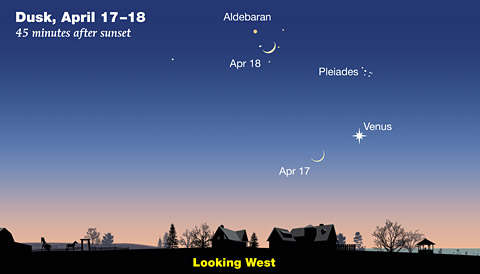This month's astronomy podcast guides you around the nighttime sky during April, giving you easy-to-follow help for finding bright planets and key stars after the Sun goes down.
April is one of the better months for stargazing. Spring evenings are generally pleasant, and the bugs haven’t taken control — yet! Even with daylight time in effect, evening twilight comes fairly early. You’ll find that the Sun sets between 7:30 and 8:00 p.m. during most of this month, and by 9 p.m. it’s good and dark.

Sky & Telescope
There won’t be much moonlight to interfere with early-evening stargazing until the last part of the month. Look for Venus low in the west not long after sunset. Week by week it will stay up longer and set later.
This "evening star" outshines everything around it, which includes a great many of the stars and constellations that stargazers associate with winter. Look for Orion, the Hunter, and Taurus, the Bull — well-known constellations that will drop into the western twilight in the weeks ahead.
Look a little higher above the western horizon to find the constellation Gemini, and the "twin" stars Castor and Pollux. This month's podcast tells you how to tell which star is which.
Over in the east, another bright planet makes its appearance by about 9 or 10 p.m. (Do you know which one? Our astronomy podcast will tell you!) And the Big Dipper looms high in the north, hanging from its handle and dumping make-believe droplets onto the landscape below.
There's plenty more to see and enjoy after the Sun goes down, so play or download this month's 6-minute-long astronomy podcast (linked below).
Podcast: Play in new window | Download
Subscribe: Apple Podcasts | Google Podcasts | Spotify | Email | RSS | More
 0
0
Comments
You must be logged in to post a comment.